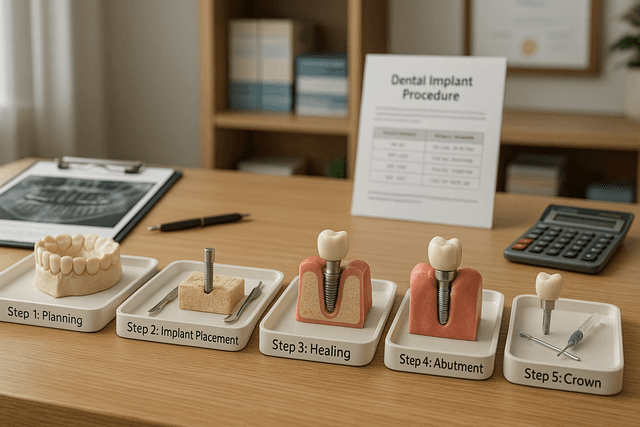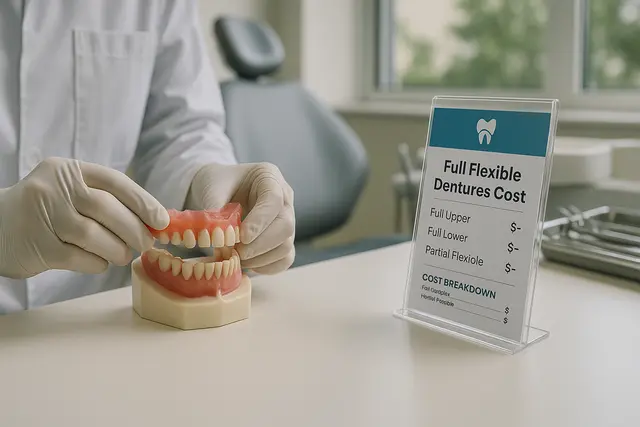Prosthodontics
5 min read
Jul 20, 2025
Crown vs Filling Chipped Tooth: A Dentist’s Guide to Quick Repair
Chipping a tooth can turn an ordinary day into a stressful one fast. Whether it happened mid-bite or during a fall, figuring out how to fix it can feel overwhelming. Should you get a filling, or is a crown the better option? Knowing the difference can save your tooth and your sanity.

So, you chipped a tooth. Maybe it was a popcorn kernel, maybe a surprise olive pit, or maybe you bit into something way too ambitious. Whatever the culprit, one thing’s clear: you need it fixed, fast. But now you’re stuck wondering about the crown vs filling decision. Which one’s right for your tooth, and how do you even tell?
Let’s break it all down with real talk from your friendly neighborhood dentist.
Understanding Tooth Damage and Why It Matters
Your tooth isn’t just a rock sitting in your mouth. It’s living tissue layered with enamel, dentin, and pulp. A chip might seem small, but depending on the depth, location, and impact on your tooth structure, it can cause way more problems than just a jagged smile.
If the chipped tooth exposes sensitive areas or leaves sharp edges, it might lead to pain, sensitivity, or even infection. That’s where a quick, well-informed repair comes in to save the day, and your tooth.
What a Filling Does for a Tooth
If your chip is minor and the extent of tooth damage is small, a filling may be sufficient. A dental filling is a straightforward repair that seals off cracks or chips and restores the look and function of your tooth. We’ll typically use a composite filling material that matches your natural teeth, so it blends right in.
A filling and a crown are both repair tools, but a filling is best when the damage isn’t too deep or wide. Say you’ve got a small chip or minor tooth decay, something that doesn’t mess with the integrity of the tooth too much. In that case, the filling does the job without overdoing it.
When You May Need a Dental Crown Instead
If the tooth has a large chip, or if the damage extends into the deeper portion of the tooth, a filling might not cut it. You may need a dental crown instead.
A crown is a cap that covers the entire tooth, offering protection and restoring its shape and strength. It’s custom-made, usually in a dental laboratory, and used when there’s not enough natural tooth structure left to hold a filling.
In some cases, a tooth that has suffered extensive tooth damage or decay may even need a root canal before the crown goes on. Your dentist may recommend a dental crown if the filling won’t stay put or the tooth is severely weakened. In situations like these, emergency crown repair might be necessary.
Dental Crown vs. Filling: How to Know What’s Right
Here’s where people often get confused. The choice between a dental crown and a dental filling depends on the extent of tooth decay or the chip.
If your tooth has a large cavity, or the filling keeps falling out, or the tooth becomes sensitive and brittle, those are signs you need a crown instead of a filling. A crown will protect the tooth from further damage and restore both strength and appearance.
If, however, it’s a small chip, maybe a front tooth that cracked during lunch, your dentist might recommend a simple tooth filling.
Getting a Crown: What to Expect
Getting a crown isn’t scary. It usually takes two visits. First, we’ll numb your tooth (numb your tooth = happy tooth), clean out any decay or damage, and shape the tooth for crown placement. You’ll go home with a temporary crown while your permanent one is made in a dental lab.
Once the final crown is ready, we cement it on, and voila, your tooth is back in business. This process helps maintain the underlying tooth and restores normal function without sacrificing aesthetics.
Crown or a Filling Depends on the Tooth
Not all teeth are treated equally. The location matters. A chipped front tooth might do fine with a filling, while a molar, the chewing powerhouses, might need the durability of a crown.
It also depends on the amount of tooth left. If too much natural tooth structure is gone due to severe tooth decay or trauma, the crown is your best bet.
Crowns and Fillings Do Different Jobs
Here’s a quick comparison:
Filling: May repair minor damage.
Crown: Covers and supports a damaged or weakened tooth.
It’s all about the extent of tooth damage and how much force that tooth handles daily.
That’s why we carefully assess the size of the cavity, the decayed portion of the tooth, and any signs of a tooth fracture before choosing between crowns and fillings.
Why You Might Need a Dental Crown Instead of a Filling
If your tooth is severely compromised or if you’ve already had a filling that failed, your dentist may recommend a dental crown. Sometimes, placing a dental crown is the only way to restore strength and function to a decayed or damaged tooth.
It’s not just about covering the damage, it’s about keeping the underlying tooth healthy in the long run. That’s the magic of dental crowns. They don’t just fix, they prevent.
Dental Crowns and Fillings Can Work Together
In some cases, it’s not an either-or decision. A dentist might use a filling to build up the base and then place a crown over it for added strength. This combination helps preserve natural tooth structure while giving it lasting support.
Like dental crowns and fillings, some situations call for teamwork. Your dentist looks at a bunch of factors: the extent of tooth decay, the location of the tooth, how much force it absorbs, and your specific dental needs. It’s never one-size-fits-all.
And yes, dental crowns cost more than fillings. But that’s because they last longer, offer more protection, and require custom fabrication. Sometimes spending more upfront saves you from bigger issues down the road.
Choosing Between a Dental Crown or Filling for Your Chipped Tooth
When chipping a tooth, the goal is to restore function and looks while preventing future damage. Whether a crown or filling is best depends on how much of the tooth is involved and how strong it is after the damage.
Your dentist will help determine if a dental crown is necessary. And if you do need a crown, don’t worry, it’s one of the most common and effective treatments in modern dental care.
Some minor damage may benefit from chipped tooth repair at home before you see your dentist.
Why a Dental Crown Is the Best Choice Sometimes
If your tooth has a huge cavity, a fracture, or repeated fillings that just aren’t holding, a dental crown is the best long-term solution. It restores strength, protects the tooth from further harm, and feels just like your natural teeth.
Think of it as a helmet for your tooth. It’s not just repair, it’s protection. After treatment, whether you’ve gotten a crown or filling, take care of your smile. Regular brushing, flossing, and dental checkups help you avoid future chips, cracks, or cavities.
When you work with a trusted dentist who understands your specific dental needs, you’re not just getting a quick fix, you’re getting a long-term partner in dental health.
When Should I Choose a Dental Filling Over a Crown?
A dental filling is ideal for small chips or minor decay where the tooth’s structure is still strong. If the damage is shallow and doesn’t compromise the integrity of the tooth, a filling made from composite resin can restore its function and appearance quickly and effectively.
When Is a Dental Crown a Better Option Than a Filling?
A crown is the better choice when the damage is more extensive, such as a large chip, deep decay, or a weakened tooth that can’t support a filling. Crowns provide full coverage and long-term strength, especially for back teeth that handle heavy chewing.
Can a Chipped Front Tooth Be Fixed Without a Crown?
Yes, if the chip is minor and doesn’t affect the tooth’s strength or nerve, a composite filling is often enough to repair a chipped front tooth. It’s a quick, cosmetic fix that blends naturally with the surrounding teeth.
What Factors Help Decide Between a Crown and a Filling?
Your dentist will consider the size and location of the damage, how much healthy tooth remains, and how much pressure the tooth endures daily. If the tooth is compromised or has had previous failed fillings, a crown may be necessary to ensure lasting protection.
Read Next
Related Posts

Prosthodontics
Dental Implant Procedure: Steps Explained From Start to Finish
Missing teeth can impact more than just your appearance, they can affect how you speak, eat, and feel about yourself. Dental implants offer a long-lasting solution that looks and feels like natural teeth. Understanding how the process works can help you feel more confident about your decision.
4 min read
Sep 03, 2025

Prosthodontics
Permanent Front Tooth Dental Bridge: How It Restores Your Smile
A missing front tooth can impact more than just your appearance, it can affect your confidence, speech, and even how you eat. Fortunately, modern dental solutions like permanent dental bridges offer a reliable and natural-looking way to restore both function and aesthetics to your smile.
5 min read
Sep 03, 2025

Prosthodontics
Flexible Dentures Cost: How It Compares to Other Denture Types
Choosing the right dentures can feel overwhelming, especially when you're navigating a wide range of prices, materials, and treatment options. Whether you're considering full, partial, flexible, or implant-supported dentures, understanding the cost breakdown is key to making a confident decision.
5 min read
Sep 03, 2025
Don’t have time to research every dentist around you?
See why 30k+ patients trusted us